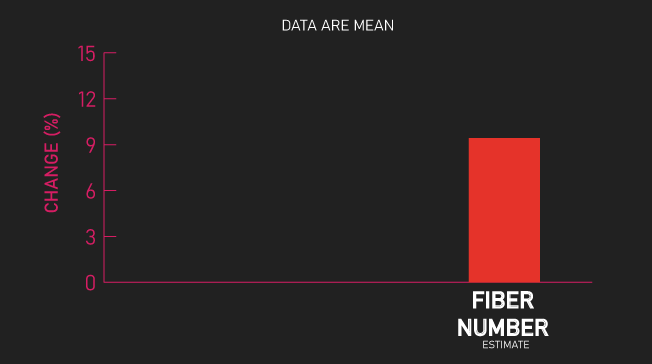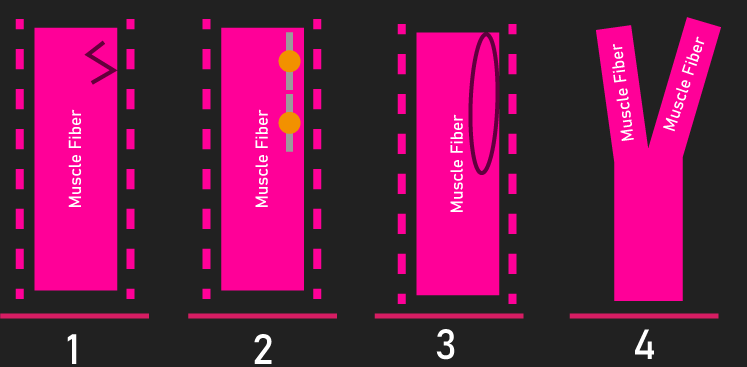
In response to resistance training, muscles typically increase in size.
One of the most commonly accepted and supported ways that this occurs is via an increase in the size of their individual muscle fibers. This whole process is called muscle hypertrophy.
However, another plausible way muscle could increase in size is through something called muscle hyperplasia.
Muscle hyperplasia refers to an increase in the number of muscles fibers within a muscle.
In theory, this could be achieved by completely new muscle fibers being manufactured, or by pre-existing muscle fibers splitting into two.
In this video, we’ll thoroughly examine the existing research on muscle hyperplasia, with the primary aim of answering if muscle hyperplasia truly occurs in humans.
Table of Contents
The Animal Research
Although we’ll be assessing human research shortly, animal studies are highly valuable for potential insights into muscle hyperplasia.
As we’ll come to find out, there are major methodological and ethical constraints that limit the quality and validity of human research in this area.
With studies conducted on animals, these constraints become less of a problem.
How Researchers Train the Animals
First things first, for researchers to explore if muscle fiber number can increase, they need to train the animals in some form.
Commonly, this is done in one of three ways: stretching, synergistic ablation, or weight training.
Stretching involves using some piece of weighted equipment to stretch a muscle of an animal.
For instance, below depicts how a study by Alway et al. stretched the anterior latissimus dorsi of Japenese quails.

Note, I did say anterior latissimus dorsi. Interestingly, Japenese quails also have a posterior latissimus dorsi.
In animal studies that use stretching to train the muscle, they either do so chronically or intermittently.
In studies that chronically stretch the animal, they typically stretch the muscle for 30 whole straight days.
Conversely, in studies that use intermittent stretching, they stretch the muscle for 1 whole day, followed by 2-3 days of rest. This cycle is repeated throughout the full duration of the study.
As we can see, these stretching protocols are extreme. Consequently, we should be extremely cautious in trying to extrapolate results from studies using this to humans.
As for synergistic ablation, this is undoubtedly more extreme.
It involves surgically removing a muscle from a muscle group, thereby overloading the remaining muscles in that muscle group.
Most commonly, this technique is used in rodents and involves surgically removing the gastrocnemius from the calf muscle group, thereby resulting in the soleus being significantly overloaded during normal tasks.
As this is method is highly extreme, we also need to be extremely cautious in trying to extrapolate results from studies using this to humans.
Finally, weight training involves having animals perform exercises in a similar way to humans.
For instance, this study by Tamaki et al. used a custom piece of equipment to get rats to squat for 15 sets of 15 repetitions with a 65-75% one-rep max load.

As this method is substantially more comparable to what humans do, studies using this method may be considered more applicable to humans than the other two methods.
How Researchers Measure an Increase in Muscle Fiber Number
Okay, so now that we’ve established the various ways in which researchers can train the muscles of animals, let us establish how they can measure if muscle fiber number has increased.
There seem to be two ways of doing this, either via direct counting or counting from a cross-section.
Direct counting involves removing the whole muscle and counting every single muscle fiber.
Of course, this can only be performed once. You can’t perform this method before and after a training duration, as once you’ve removed the muscle, it cannot be put back.
Therefore, to determine if the number of muscle fibers has increased, there are two plausible ways used.
In the first way, researchers get the animals to train only one side of their body, while their other side of the body remains untrained.
Then, after a training duration, if the number of muscle fibers in the trained muscle is more than the number of muscle fibers in the untrained muscle, we assume that training increased muscle fiber number.
The underlying assumption here is that before the training period, the trained and untrained muscles would have had a comparable number of muscle fibers. This may not always be an accurate assumption and is thus a limitation.
The second way involves using the direct counting method to compare the number of muscle fibers within the muscles of an animal that trained to an animal that did not train.
After a training duration, if the number of muscle fibers in the muscle of a trained animal is greater than the number of muscle fibers within the muscle of an untrained animal, we assume that training increased muscle fiber number.
The underlying assumption here is that before the training duration, the number of muscle fibers between the trained and untrained animals would have been similar.
Again, this may not always be an accurate assumption and is thus a limitation.
Now, one major advantage of this method is that as the whole muscle is removed, all of the muscle fibers are counted from the muscle of the animals.
However, this also makes it somewhat unpractical for researchers, as the dissection of a whole muscle and counting of potentially ten’s of thousands of muscle fibers can be difficult.
The second method, counting from a cross-section, somewhat solves this impracticality.
It involves removing only a cross-section from the muscle and then counting the number of muscle fibers in this cross-section.
For practical reasons, I believe researchers don’t take a cross-section from the muscle of the same animal before and after a training duration.
Therefore, like the last method, researchers either compare the number of muscle fibers counted between a trained side and untrained side, or between an animal that trained and an animal that didn’t train.
Counting the number of muscle fibers in a cross-section is potentially more practical, as only a sample is required.
However, there is a vital limitation with this method.
It’s very possible that the number of muscle fibers in a cross-section could increase without an actual increase in muscle fiber number.
One example of this is when an increase in the pennation angle of the muscle fibers outpaces the growth of the muscle fibers.
Let me explain.
Remember, muscles attach to bones in order to create movement in the human body.
A muscle has two attachment points.
Some muscles in the human body do not have their muscle fibers run in a straight line from their two points of attachment.
Rather, some muscles have their fibers angled slightly between the two points of attachment.

The pennation angle is the name given to the angle of the muscle fibers.
When assessing a particular cross-section of a muscle, if an increase in pennation angle outpaces the growth of the individual fibers, more muscle fibers could be observed in that cross-section, despite there being no actual increase in muscle fiber number.

Another example in where more muscle fibers could be observed in a cross-section without an actual increase in muscle fiber number relates to an increase in muscle fiber length.
Some muscle fibers may not actually run the full length of a muscle and with training, there is evidence muscle fibers can increase in length.
Therefore, when assessing a particular cross-section of a muscle, it’s possible that a muscle fiber could increase in length to the point where it is now newly observed in that cross-section.

In general, as a result of these potentially vital limitations when counting muscle fibers from a cross-section, a direct count is considered more reliable.
The Findings in the Animal Research
Hopefully we’ve now got a solid understanding of how researchers can train and measure an increase in muscle fiber number in animals.
Let us now look at the results of such studies.
A meta-analysis by Kelley combined the results of numerous animal studies.
What the analysis found was that muscle fiber number increased by 20.95% in studies that had animals stretch, 11.59% in studies that had animals weight training, and 5.44% in studies that used synergistic ablation.

As we noted, given that studies using stretching or synergistic ablation are quite extreme and not applicable to what humans do, the weight training data is most relevant and insightful.
Specifically, 5 studies were comprised in the weight training results. 3 of them involved counting from cross-sections, while 2 involved direct counting.
All 5 of these studies found an increase in muscle fiber number, and so this includes the 2 studies that used direct counting.
As mentioned earlier, given direct counting is considered more reliable than counting from cross-sections, and the 2 direct counting studies found an increase in muscle fiber number, this adds to our confidence muscle hyperplasia may indeed increase with weight training (at least in animals).
Human Research
Alright, so the animal evidence seems to suggest that weight training-like stimuli may induce muscle hyperplasia.
But, results obtained from animals studies may not necessarily apply to humans.
The Problem With Counting Muscle Fibers in Humans
Unfortunately, there are major ethical and practical constraints when attempting to find out if muscle hyperplasia occurs in humans.
Recall that the direct method of counting muscle fibers involves removing a whole muscle and counting all of the fibers.
The first major problem here is that I’m not too sure there are many humans out there willing to have one of their muscles completely removed.
Even if there were willing human subjects, and a researcher could get clearance, human muscles can contain hundreds of thousands of muscle fibers, making the direct counting of all of them extremely impractical.
For instance, it’s broadly estimated that the biceps brachii of humans contains anywhere from 198,000 to 419,000 muscle fibers.
As far as I’m aware, counting from a cross-section has also not been done in humans.
I think this because it’s too difficult to obtain a large enough sample from human muscles to be considered valid.
Despite all of this, researchers have used other ways in trying to find out muscle hyperplasia occurs in humans.
Cross-Sectional Studies
There have been 4 cross-sectional studies finding potential indirect evidence that muscle fiber number may increase with training (one, two, three, and four).
Specifically, these studies compared muscle characteristics between a group of trained bodybuilders or powerlifters to a group of untrained individuals.
As you’d expect, the bodybuilders and powerlifters had larger whole muscle cross-sectional areas than the untrained individuals.
However, the cross-sectional area of the individual muscle fibers assessed was not different between the untrained individuals and the bodybuilders or powerlifters.
This led the researchers to suggests that the greater whole muscle cross-sectional area observed for the bodybuilders or powerlifters could be due to having more muscle fibers that are produced by training.
However, there is still a whole host of problems with this.
One major one is that human studies can only assess the size of a limited number of muscle fibers.
This is because to assess the size of individual muscle fibers, a small sample must first be taken from the muscle.
The muscle fibers in this small sample may not be identical to muscle fibers elsewhere in the muscle.
Therefore, it’s possible the muscle fibers in other regions of the muscle that were never sampled could have been larger in the bodybuilders or powerlifters compared to the untrained individuals, thereby explaining the larger whole muscle size.
Splitting Of Muscle Fibers in Humans?
Nevertheless, aside from these similar 4 cross-sectional studies, there is another cross-sectional study by Eriksson et al. finding potential evidence for muscle hyperplasia in humans.
They found that in trained powerlifters, there were signs of splitting from muscle fibers obtained from the vastus lateralis and trapezius.
The splits varied in depths, but the authors noted that some splits did completely divide the fibers.
They also assessed a group of untrained individuals, in which no splitting of muscle fibers from the vastus lateralis or trapezius was found.
Therefore, this study suggests the powerlifters may have experienced an increase in muscle fiber number via splitting of pre-existing muscle fibers.
Evidence Against an Increase in Muscle Fiber Number in Humans
Although the mentioned 5 cross-sectional studies potentially imply humans may experience muscle hyperplasia, other human studies suggest otherwise.
A study by Schantz et al. compared 5 bodybuilders to 18 untrained individuals.
Contrary to much of the previous cross-sectional studies we detailed, the bodybuilders had a larger whole muscle and larger individual fiber cross-sectional areas compared to the untrained individuals, suggesting it was the larger individual muscle fibers that perhaps explained the larger whole muscle size.
A study by MacDougall et al. found the same thing.
A group of bodybuilders had a larger bicep cross-sectional area and biceps muscle fiber cross-sectional area compared to untrained individuals.
Moreover, using a simple equation, the researchers attempted to estimate fiber numbers in the subjects.
What they did, for each subject, was divide the cross-sectional area of their biceps by the average cross-sectional area of the muscle fibers in their biceps.
The cross-sectional area of the biceps was corrected for any impact connective tissue would have had.
Therefore, the result of this equation would give a very rough estimate of how many fibers each subject may have had in their biceps.
Overall, the researchers found that the fiber numbers in the bodybuilders were similar to the untrained individuals, thus potentially suggesting muscle fiber numbers do not increase with training.
Finally, a study by Mccall et al. actually used the same equation we just mentioned, but in a long-term study design.
They had 8 trained men train a variety of free weight and machine exercises, each for 3 sets of repetition to failure with a 10 rep-max load, for 3 times per week for 12 weeks.
Before and after the study, the researchers measured biceps cross-sectional area, cross-sectional area of a portion of muscle fibers from the biceps, and fiber numbers within the biceps via the mentioned equation.
After the 12 week training duration, biceps cross-sectional area and biceps fiber cross-sectional area increased. But, estimated fiber numbers did not.

So the results of this study would seem to suggest that muscle fiber number does not increase with training in humans.
However, the authors mentioned something quite interesting.
2 subjects experienced quite high increases in cross-sectional area of a few muscles fibers from the biceps (specifically the fast-twitch fibers), but they experienced similar overall increases in biceps cross-sectional area to the other 6 subjects.
In other words, it seems like these 2 subjects were outliers.
When these 2 subjects were removed from the fiber number estimated data, the average of the remaining 6 subjects did display an increase in fiber numbers.

Therefore, perhaps this study did actually find muscle hyperplasia in humans.
However, as with pretty much all the human studies we’ve been assessing, there are limitations.
Firstly this data is only from 6 subjects, which is an extremely small sample size. On top of this, the equation used to estimate fiber number is very rough, and there are many scenarios in which it can be inaccurate.
Before moving on, if you’re curious about creating an effective training program for muscle hypertrophy, our high quality partner Alpha Progression can help. It can generate a highly effective program for you, track your workouts live with in-built progression recommendations, provide graphs displaying your long term progress, and it has a massive exercise database with more than 550 exercises.
Click HERE (the link opens in a new tab) to get a free 2 week trial of the apps features. If you like it and go beyond, the link also gives you 20% off a subscription!
We never promote trash at the House of Hypertrophy, so rest assured the app is high quality. The reviews speak to this, 4.8 starts (based on more than 7,000 reviews) on Google play, and 4.9 stars in Apple’s store (based on nearly 400 ratings).
Conclusion on Human Evidence
To sum up the human evidence, it’s clear to see there is no distinct answer on whether muscle hyperplasia occurs.
Not only are there conflicting results, but the individual studies on both sides of the argument are highly questionable in quality and validity.
Of course, in large part, this is simply because direct fiber counting is impossible in human subjects.
Combining the Animal and Human Studies
When combining and analyzing the animal and human evidence together, I think there are a couple of different viewpoints a person could take.
Perhaps you think that the human evidence is not particularly valuable (due to the limitations), but given the animal evidence may suggest fiber number can increase with weight training, you view this as promising evidence that fiber number similarly increases in humans.
Or perhaps you think that promising animal evidence coupled with a few indirect human studies may be sufficient to believe an increase in muscle fiber number occurs in humans.
On the other hand, perhaps you believe animal studies are not particularly useful and combined with the mixed and questionable human studies, you’re skeptical or just uncertain if fiber number can increase in humans.
Of course, these are not the only viewpoints you can take, they are just some that readily came to my mind.
All in all, I think the all of viewpoints could be justified.
Role of Anabolic Steroids
Moving on, I think a discussion on the potential role of anabolic steroids in increasing muscle fiber numbers could be interesting.
Recall we detailed 4 cross-sectional studies finding that a group of bodybuilders or powerlifters had a larger whole muscle cross-sectional area, yet similar individual muscle fiber cross-sectional area to untrained individuals, potentially indicating an increase in muscle fiber number explains the larger whole muscle cross-sectional area in the bodybuilders or powerlifters.
In 3 of these 4 studies, some bodybuilders and powerlifters had used or were using anabolic steroids (one, two, and three).
Therefore, perhaps this suggests users of anabolic steroids may be the most susceptible to increasing muscle fiber numbers.
A couple of studies by Eriksson et al. further supports this.
In two studies (one and two), they found that compared to a group of natural powerlifters, a group of powerlifters on steroids had a higher percentage of muscle fibers from the trapezius and vastus lateralis expressing proteins that would be present when new muscle fibers are created.
In a third study, they found that in the trapezius and vastus lateralis, more powerlifters on steroids displayed signs of splitting muscle fibers than natural powerlifters.
Having said all of this, there is also evidence that anabolic steroids may have no impact on muscle fiber numbers.
Recall we also mentioned a study by MacDougall et al. who used an equation to estimate rough fiber numbers in the biceps of bodybuilders and untrained individuals.
All of the bodybuilders in this study were on anabolic steroids, yet the results found similar fiber numbers between them and the untrained individuals, suggesting anabolic steroids had no effect on fiber numbers.
In summary, it’s quite plausible that anabolic steroids enhance or make an increase in muscle fiber number more likely, but unfortunately the human evidence isn’t sufficient enough to verify or falsify this claim.
Why Might Fiber Number Increase?
As we’ve seen throughout the video, the evidence is far from conclusive on whether muscle hyperplasia occurs in humans.
But let’s assume for a second it does.
What would be the body’s reason for increasing muscle fiber number?
There are two pretty interesting hypotheses I’ve come across that I thought would be worth sharing in this video.
Abnormal Damage Regeneration Response
The first one suggests an increase in muscle fiber number may be due to an abnormal regeneration response to damaging exercise.
At a fundamental level, this suggests that when muscle fibers are damaged as a result of hard or novel training, the recovery process may abnormally result in the splitting of pre-existing muscle fibers.
To go into more detail, a paper by Murach et al. put forth two potential ways in which this could occur.
The first is where a damaged muscle fiber (1 in image below) is degraded (2 in image below). Then, satellite cells (which are cells involved in muscle regeneration) irregularly fuse to the muscle fiber (3 in image below). The satellite cells then differentiate (which means to transform) into undeveloped muscle fibers (4 in image below), and once they develop, a split muscle fiber appears (5 in image below).

The second is where the muscle fiber experiences damage on one side of its outer wall (1 in the image below). Satellite cells fuse to this particular location (2 in the image below) and differentiate into an undeveloped muscle fiber (3 in the image below), and once they develop, a split muscle fiber appears (4 in the image below).

Now, there is some evidence to potentially support either of these.
When overviewing the animal evidence earlier in this video, we noted how stretching and synergistic ablation protocols increased muscle fiber number. These protocols are quite extreme and likely involve significant damage and regeneration responses, meaning an abnormal regeneration response could explain the increase in fiber numbers.
Moreover, recall we mentioned a study by Eriksson et al. finding in trained powerlifters, there were signs of splitting from muscle fibers obtained from the vastus lateralis and trapezius.
Something we haven’t mentioned is the researchers found the splitting was coupled with evidence of dead muscle fiber segments and muscle fibers attempting regeneration.
Hence, an abnormal damage regeneration response may explain the splitting muscle fibers in the trained powerlifters.
Muscle Fibers Reaching a Critical Size Threshold
Aside from an abnormal damage regeneration response, another potential reason the body might increase muscle fiber number relates to individual muscle fibers reaching a certain size threshold.
This suggests that an individual muscle fiber grows up to a certain size. From here, the individual muscle fiber splits into two.
Supporting evidence for this comes from a fascinating study done by Murach et al. on mice.
They found that after 8 weeks of progressive weighted wheel running, the cross-sectional area of the soleus muscle fibers had increased, with no changes in muscle fiber number.
However, by the 12th week of training, the cross-sectional area of the soleus muscle fibers had decreased, with a concurrent increase in muscle fiber number.
Therefore, this likely suggests that the mice’s soleus muscle fibers increased in cross-sectional area for 8 weeks, but thereafter split, producing the increase in fiber number and decrease in muscle fiber cross-sectional area.
This brings up an interesting question, why might a muscle fiber split upon reaching a certain size?
I think one of the strongest answers to this relates to oxygen.
Typically, oxygen diffuses from capillaries to mitochondria that are located within a muscle fiber. Mitochondria can then utilize oxygen to generate energy that can power muscle force production.

However, as muscle fibers continuously enlarge, and given mitochondria concentrations do not appear to increase with resistance training, and may even decrease, there could come a point where it’s too difficult for oxygen to diffuse out from capillaries to certain mitochondria within the fiber, due to an excessively large diffusion distance.
As a result, the muscle fiber splits into two, thereby resulting in two smaller muscle fibers that should have no issue with oxygen diffusion distances.
Indeed, there is evidence from rats and crabs that fibers may split when diffusing oxygen across a muscle fiber becomes difficult.
Concluding Remarks
To conclude, despite there being some interesting hypotheses behind why the body may increase muscle fiber number, the current research on whether muscle hyperplasia occurs in humans from training is far from clear.
When overviewing the current animal and human research, some may believe it is promising in suggesting fiber numbers may increase, whereas others may think otherwise.
Ultimately, due to the major limitation in studying whether muscle fiber number can increase in humans, I’m not sure we’re going to get a conclusive answer anytime soon.
Perhaps if non-invasive technologies can be developed to accurately count muscle fiber numbers in the future, we’ll be able to make firmer conclusions.
Remember to feel free to check out the Alpha Progression App if you’re interested. Also feel free to check out our free bench press e-book below.

